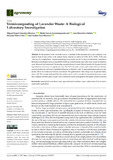Mostrar el registro sencillo del ítem
Vermicomposting of lavender waste: a biological laboratory investigation
| dc.creator | González Moreno, Miguel Ángel | es_ES |
| dc.creator | García Gracianteparaluceta, Beñat | es_ES |
| dc.creator | Marcelino Sádaba, Sara | es_ES |
| dc.creator | Prieto Cobo, Eduardo | es_ES |
| dc.creator | Seco Meneses, Andrés | es_ES |
| dc.date.accessioned | 2023-02-17T12:33:31Z | |
| dc.date.available | 2023-02-17T12:33:31Z | |
| dc.date.issued | 2022 | |
| dc.identifier.citation | González-Moreno, M. Á., García Gracianteparaluceta, B., Marcelino Sádaba, S., Prieto Cobo, E., & Seco Meneses, A. (2022). Vermicomposting of Lavender Waste: A Biological Laboratory Investigation. Agronomy, 12(12), 2957. https://doi.org/10.3390/agronomy12122957 | en |
| dc.identifier.issn | 2073-4395 | |
| dc.identifier.uri | https://hdl.handle.net/2454/44755 | |
| dc.description.abstract | In the present work, lavender waste, a residue of the essential oil extract industry, was used to feed Eisenia andrei with mature horse manure at ratios of 0:100, 25:75, 50:50, 75:25 and 100:0 on dry weight basis. Vermicomposting was carried out for 70 days in laboratory conditions. Biological parameters such as population build-up, total biomass, mortality and cocoon production were observed and measured. Increasing concentrations of waste affected positively the growth and reproduction of worms in a significant way. The 100% lavender waste combination showed the best cocoon production and even tripled their biomass in the first week. A seed germination test was also made, where no evidence of toxicity was found. The germination index range was, in general terms, above 100. The results indicated that the earthworm E. andrei was able to transform lavender waste into compost and thus play a major role in industrial waste management and apply circular economy. | en |
| dc.description.sponsorship | This research was funded by the Government of Navarre and European Regional Development Fund (ERDF) grant number VERMICOMPOSTAJE 4.0 (0011-1365-2019-000110) research project. The APC was funded by Euskoiker Foundation. | en |
| dc.format.mimetype | application/pdf | en |
| dc.language.iso | eng | en |
| dc.publisher | MDPI | en |
| dc.relation.ispartof | Agronomy 2022, 12, 2957 | en |
| dc.rights | © 2022 by the authors. This article is an open access article distributed under the terms and conditions of the Creative Commons Attribution (CC BY) license. | en |
| dc.rights.uri | http://creativecommons.org/licenses/by/4.0/ | |
| dc.subject | Essential oil extraction waste | en |
| dc.subject | Agro-industrial residues | en |
| dc.subject | Waste valorization | en |
| dc.subject | Eisenia andrei | en |
| dc.subject | Sustainable agriculture | en |
| dc.title | Vermicomposting of lavender waste: a biological laboratory investigation | en |
| dc.type | Artículo / Artikulua | es |
| dc.type | info:eu-repo/semantics/article | en |
| dc.date.updated | 2023-02-17T12:26:41Z | |
| dc.contributor.department | Ingeniería | es_ES |
| dc.contributor.department | Ingeniaritza | eu |
| dc.contributor.department | Institute of Smart Cities - ISC | en |
| dc.rights.accessRights | Acceso abierto / Sarbide irekia | es |
| dc.rights.accessRights | info:eu-repo/semantics/openAccess | en |
| dc.identifier.doi | 10.3390/agronomy12122957 | |
| dc.relation.publisherversion | https://doi.org/10.3390/agronomy12122957 | |
| dc.type.version | Versión publicada / Argitaratu den bertsioa | es |
| dc.type.version | info:eu-repo/semantics/publishedVersion | en |
| dc.contributor.funder | Gobierno de Navarra / Nafarroako Gobernua | es |



